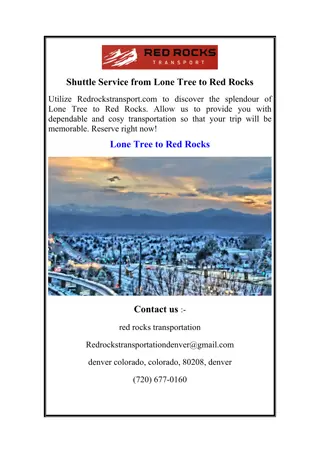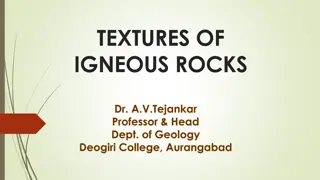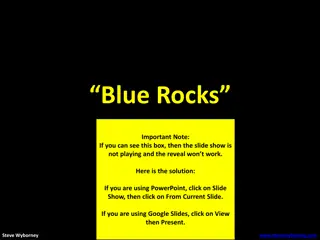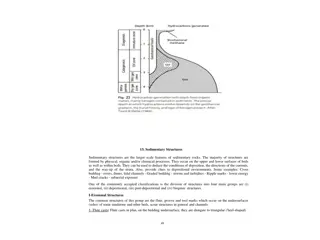Shuttle Service from Brighton to Red Rocks
Travel with Redrockstransport.com to enjoy the magnificent trip from Brighton to Red Rocks. We would be happy to take you on a memorable, beautiful journey!\n\n\/\/redrockstransport.com\/brighton-to-red-rocks-transportation\/
5 views • 1 slides
Shuttle Service from Lone Tree to Red Rocks
Utilize Redrockstransport.com to discover the splendour of Lone Tree to Red Rocks. Allow us to provide you with dependable and cosy transportation so that your trip will be memorable. Reserve right now!\n\n\/\/redrockstransport.com\/lone-tree-to-red-rocks-transportation\/
0 views • 1 slides
Understanding Diagenesis and Lithification in Sedimentary Rocks
Diagenesis and lithification are crucial processes that transform loose sediment into solid rock through compaction and cementation. Diagenesis involves various chemical, physical, and biological changes while lithification involves the pressure-induced consolidation of sediment. Compaction removes
0 views • 15 slides
Understanding Magmatic Differentiation and Magma Mixing
Magmatic differentiation is the process through which a single homogeneous magma can produce diverse rock types by generating fractions of different compositions. This variation in igneous rocks results from mechanisms like fractional crystallization, liquid immiscibility, vapor transport, and diffu
1 views • 29 slides
Understanding the Rock Cycle: Igneous, Sedimentary, and Metamorphic Rocks
This educational material covers the formation and characteristics of Igneous, Sedimentary, and Metamorphic rocks. It includes details on the processes involved, such as heat melting rocks into magma, sediment formation through erosion and deposition, and the differentiation between intrusive and ex
1 views • 16 slides
Understanding the Gondwana Super Group and Its Classification
The Gondwana Super Group, named after the Gond Kingdom, consists of sedimentary rocks deposited from the Carboniferous to Jurassic periods. These rocks provide insights into changing climatic conditions over millions of years. Classification of the Gondwana rocks is based on paleontological and lith
0 views • 23 slides
Understanding Sediment and Sedimentary Rock Textures
Discover the textures and structures of sediment and sedimentary rocks, including clastic and crystalline textures, primary and secondary textures, and the effects of compaction. Learn about sediment texture, differences in sedimentary rock texture, and the classification of grain sizes using the We
1 views • 20 slides
Understanding Textures of Igneous Rocks in Geology
Structures associated with igneous rocks are primary features that contribute to their strength, distinguish rock groups, and reveal origin. Textures, like crystalline patterns, indicate cooling and crystallization processes. Different cooling rates lead to varied textures such as holocrystalline, h
0 views • 16 slides
Exploring the Importance of Rocks in Our World
Discover the significance of rocks in our daily lives, from constructing buildings to determining soil types. Learn why rocks are essential for creating materials like metals and how they shape the planet we inhabit. Explore how rocks are formed and their crucial role in various aspects of our envir
0 views • 22 slides
Formation and Characteristics of Sedimentary and Metamorphic Rocks
Sedimentary rocks are formed through the aggregation and compaction of sediments, while metamorphic rocks result from changes in the form or composition of existing rocks. Sedimentary rocks contain layers of different sediments and are abundant on Earth's surface, while metamorphic rocks undergo met
0 views • 7 slides
Estimation Puzzle: How Many Blue Rocks in the Vase?
A fun estimation challenge where clues are provided to narrow down the possibilities of the number of blue rocks in a vase. By using critical thinking and estimation skills, participants deduce that there are 65 blue rocks in the vase. Test your estimation abilities with engaging visual clues and de
0 views • 6 slides
Esti-Mystery Challenge: How Many Rocks in the Vase?
Embark on a fun and engaging Esti-Mystery challenge to determine the number of rocks in the vase. Follow clues, use estimation, and narrow down possibilities to come up with your final estimate before the reveal of 41 rocks! Enhance your numerical reasoning skills with this interactive activity by S
0 views • 6 slides
Field Sedimentology: Methods and Tools for Sedimentary Studies
Sedimentology involves interpreting sediments and rocks in terms of transport and deposition processes, distribution in space and time. Field studies require basic equipment like a notebook, hand lens, compass, clinometer, hammer, and GPS. Palaeocurrent indicators provide evidence of flow direction
0 views • 28 slides
Importance of Rocks in Construction and Building Materials
Rocks play a crucial role in construction as geological materials for foundations and building structures. They are classified into igneous, sedimentary, and metamorphic categories based on their composition and properties. Traditional stone masonry is being replaced by modern techniques like stone
1 views • 15 slides
Understanding Sedimentary Rocks and Their Formation
Explore the world of sedimentary rocks through detailed descriptions and images. Learn about the formation process involving sediment deposition, lithification, and the various types of sedimentary rocks such as conglomerate, sandstone, shale, and more. Discover how organic sedimentary rocks like co
0 views • 20 slides
Understanding Rocks: Types, Formation, and Properties
Rocks can be classified as metamorphic, igneous, or sedimentary based on their formation processes. Florida's phosphate deposits and pumice formation showcase the diversity of rocks. A scientist's rock cycle model helps predict changes, while pressure on sediments leads to new rock formation. Basalt
1 views • 22 slides
Understanding Metamorphic Rocks: Foliated vs. Nonfoliated
Explore the characteristics of metamorphic rocks through identifying whether they are foliated or nonfoliated and determining their parent rocks. Learn about rocks like gneiss, marble, and slate, and understand concepts such as loose rock grains being called sediment.
1 views • 16 slides
Understanding Different Types of Rocks and How They Form
Rocks are essential components of Earth's crust, consisting of various minerals held together by natural cement. They can be categorized into three groups: Igneous, Sedimentary, and Metamorphic rocks. Each group is formed differently, either through volcanic activity, sedimentation, or existing rock
3 views • 16 slides
Geomechanical Effects of Oilfield Chemicals on Sand Failure in Reservoir Rocks
This study by Elizabeth O. Wuyep et al. explores the geomechanical effects of oilfield chemicals on sand failure in reservoir rocks. It discusses the role of oilfield chemicals, limitations of previous works, experimental flow chart, and static saturation tests. The research emphasizes the need for
0 views • 25 slides
Understanding Rocks and Minerals: Types and Formation
Rocks and minerals are natural substances with distinct characteristics. Rocks are solid aggregates of minerals or mineraloids, while minerals are naturally occurring chemical compounds. There are three main types of rocks: igneous, sedimentary, and metamorphic, each formed through different process
0 views • 16 slides
Sedimentary Structures: Types and Significance
Sedimentary structures are features found in sedimentary rocks that provide valuable information about the conditions of deposition, current directions, and depositional environments. They can be erosional, depositional, post-depositional, or biogenic in nature, with examples including flute casts,
0 views • 6 slides
Who Wants To Be A Millionaire: Rocks and Soils
A themed quiz featuring questions about rocks and soils, with images for each question. Test your knowledge on geology and have fun learning about different types of rocks and their uses in various applications.
0 views • 61 slides
Understanding Rocks: Types, Formation, and Importance in Geology
Rocks are solid accumulations of minerals found in the Earth's lithosphere. They are classified into igneous, sedimentary, and metamorphic types based on their mineral composition. Rocks play a crucial role as geological materials for construction and historical buildings. Learn about the properties
0 views • 31 slides
Geology Test Review: Rocks and Minerals
This review covers the identification of rocks as igneous, sedimentary, or metamorphic, along with definitions and properties of minerals like cleavage, crystal structure, streak color, and more. It also discusses the classification of rocks as foliated or nonfoliated. Prepare for your geology test
2 views • 112 slides
Exploring Rocks: A 7th Grade Science Book on the Rock Cycle
Dive into the world of rocks with this comprehensive 7th-grade science book. Learn about the different types of rocks - igneous, metamorphic, and sedimentary. Explore how rocks are formed and categorized, and discover the processes that shape our Earth's rocky landscapes. Engage in hands-on activiti
0 views • 24 slides
Understanding Rock Formation and the Rock Cycle
Explore how the Earth's surface is formed through the classification of rocks based on their processes of formation. Learn about different rock types such as igneous, sedimentary, and metamorphic rocks, and understand concepts like the rock cycle and the effects of pressure on sedimentary rocks.
0 views • 13 slides
Understanding Sedimentary Rock Characteristics: Provenance and Weathering
Explore the significance of provenance analysis in interpreting the origin of sedimentary rocks based on lithological characteristics. Learn about mechanical and chemical weathering processes, compositional and textural maturity, mineral stability during weathering, and how rock particles indicate t
0 views • 12 slides
Understanding Sedimentology: An Overview of Sedimentary Processes and Rocks
Sedimentology is the study of modern sediments like sand, mud, and clay, along with the processes involved in their deposition. Sedimentologists use this knowledge to interpret Earth's geologic history through sedimentary rocks and structures. Sediment plays a crucial role in enriching soil with nut
0 views • 27 slides
Enigmatic Triassic Rocks and Reptile Trackways in Fairfield, Pennsylvania
Structurally isolated, highly metamorphosed carbonate rocks at Valley Quarries in Fairfield, Pennsylvania were dated to the Triassic period using reptile trackways, providing insight into the region's geology. Discovery of various footprints revealed unique lithologies and ancient environments, incl
0 views • 15 slides
Understanding Metamorphic Rocks in 7th Grade Science
Metamorphic rocks are formed deep beneath the Earth's surface through heat and pressure, leading to changes in the rock's structure. Geologists classify these rocks based on grain arrangement into foliated (layered) and nonfoliated (random). Examples include slate, schist, gneiss, marble, and quartz
0 views • 6 slides
Evolution of North America's Rocks: Plate Tectonics Influence
Late Precambrian rocks in North America underwent a transition from belt supergroup rocks deposited in intracontinental basins to miogeoclinal rocks along the continent margins. This change was attributed to plate tectonics, with significant deposition in cratonic basins and edges. The shift at 850
0 views • 8 slides
The Impact of Syn-Sedimentary Compaction on Delta Morphodynamics
This study examines the influence of syn-sedimentary compaction on delta development, particularly focusing on how compaction affects delta morphology. It addresses the lack of field measurements by proposing simulation models as an alternative approach to understanding the link between compaction a
0 views • 12 slides
Understanding Microfacies Analysis in Sedimentary Geology
This chapter discusses field work studies, sampling strategies, and laboratory methods essential for microfacies analysis. It emphasizes the importance of precise field records, vertical and lateral variations in sampling, and studying microscopic features along with mineralogical and geochemical da
0 views • 22 slides
Dispersed Organic Matter in Sedimentary Rocks - Review Paper for Geological Application Studies in the 21st Century
The WG on Dispersed Organic Matter in Sedimentary Rocks is working on a review paper focusing on application studies of dispersed organic matter (DOM) within a geological context. The paper aims to provide an insightful overview titled "Applications of Dispersed Organic Matter Petrology in the 21st
0 views • 18 slides
Understanding the Symbolism of Rocks in Biblical Context
Exploring the significance of rocks in the Bible, this content delves into the metaphorical meaning of stones as reminders of God's faithfulness and as witnesses to His mighty works. Drawing from verses in Joshua and Numbers, the concept of rocks serving as witnesses and sources of nourishment is hi
0 views • 21 slides
Understanding Rocks: Composition, Importance, and Role in Earth's Evolution
Rocks, composed of various minerals, form the materials of the earth's crust. They play a crucial role in shaping erosion patterns and landforms, with their composition influencing the landscape evolution over time. Rocks are key in dating earth's history and understanding geological processes. Expl
0 views • 4 slides
Understanding Rocks and the Rock Cycle
Explore the world of rocks through this educational content on Earth's surface, rock cycle, rock types (igneous, sedimentary, metamorphic), and the formation of igneous rocks from magma and lava. Learn how rocks are made of minerals, the continuous process of the rock cycle, and the classification o
0 views • 29 slides
Understanding the Rock Cycle Process
Exploring the rock cycle, which involves the formation, transformation, and breakdown of rocks into three main types: sedimentary, igneous, and metamorphic. Learn about how rocks change through processes like heat, pressure, erosion, and melting.
0 views • 9 slides
Understanding Rock Classification in 7th Grade Science
When studying rocks, scientists analyze their mineral composition, color, and texture. Rock-forming minerals play a significant role in Earth's geology, with granite and basalt being prime examples. The texture of rocks is determined by the size, shape, and pattern of grains present. Rocks form thro
0 views • 9 slides
Exploring Soil, Rocks, and Minerals
Explore the wonders of soil, rocks, and minerals through engaging activities like separating soil components, testing drainage, and understanding rock formation. Discover how rocks are made, including volcanic and sedimentary rocks. Enhance your knowledge and have fun learning about the Earth's mate
0 views • 8 slides







































